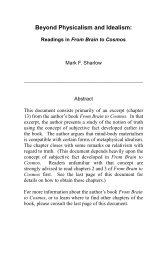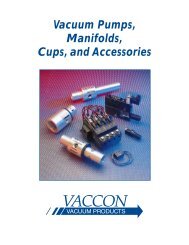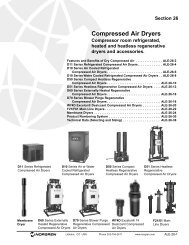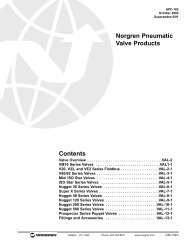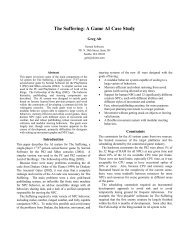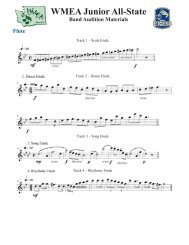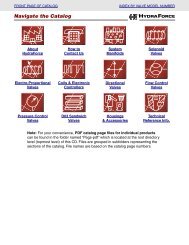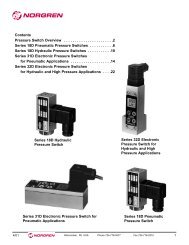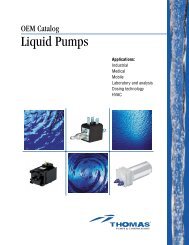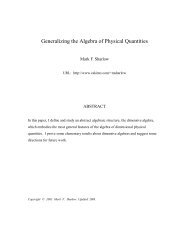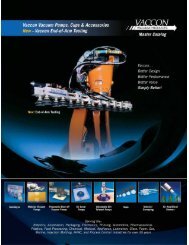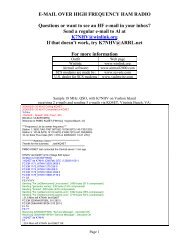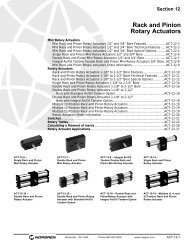Navigate the Catalog HYDRAFORCE
Navigate the Catalog HYDRAFORCE
Navigate the Catalog HYDRAFORCE
- No tags were found...
You also want an ePaper? Increase the reach of your titles
YUMPU automatically turns print PDFs into web optimized ePapers that Google loves.
COILS AND ELECTRONIC CONTROLS<br />
Proportional Valve Controllers—Set-up Instructions<br />
SETUP INSTRUCTIONS<br />
Preparation<br />
Make sure that <strong>the</strong> controller/amplifier is connected to an<br />
operating proportional valve.<br />
For <strong>the</strong> coil mount version, use a small screwdriver to loosen<br />
<strong>the</strong> mounting screw and remove <strong>the</strong> transparent cover.<br />
Use a jeweler’s size screwdriver (slotted 1.5) to make adjustments<br />
to <strong>the</strong> trim pots.<br />
For <strong>the</strong> metal box style, use a screwdriver to remove <strong>the</strong> metal<br />
cover. Use a small screwdriver to make adjustments to <strong>the</strong> trim<br />
pots.<br />
Interaction Between Maximum Current (I-Max.)<br />
and Minimum Current (I–Min.) Adjustments<br />
• Adjusting <strong>the</strong> maximum current (I-Max.) does not affect <strong>the</strong><br />
minimum current (I-Min.) setting.<br />
• Adjusting <strong>the</strong> minimum current (I-Min.) will shift <strong>the</strong> maximum<br />
current (I-Max.) setting.<br />
Solenoid Current (amps)<br />
2<br />
1<br />
Factory Setting: I-Max. = 100%; I-Min. = 0%<br />
Adjustment to I-Max. = 50%; I-Min. remains at 0%<br />
Input<br />
Voltage/Current<br />
Solenoid Current (amps)<br />
Offset = I-Min<br />
Slope = I-Max<br />
100% Input<br />
Voltage/Current<br />
Setting <strong>the</strong> Minimum Current (I–Min.)<br />
The minimum setting can be used to take into account <strong>the</strong><br />
mechanical valve deadband and provide desired offsets from<br />
zero to allow full control within <strong>the</strong> functional range of <strong>the</strong><br />
specific valve.<br />
1. Set <strong>the</strong> minimum current before setting <strong>the</strong> maximum<br />
current.<br />
2. Apply appropriate minimum input (4mA, 0V or<br />
potentiometer, 0V or 0A).<br />
3. The factory setting for <strong>the</strong> I-Min. trim pot is zero,<br />
fully counterclockwise (CCW).<br />
4. If <strong>the</strong> desired minimum current is greater than zero,<br />
adjust <strong>the</strong> trim pot clockwise (CW) until <strong>the</strong> desired<br />
current is achieved.<br />
Setting <strong>the</strong> Maximum Current (I–Max.)<br />
1. Apply appropriate maximum control (20mA, 5V or control<br />
pot at maximum, 10V)<br />
2. Factory setting for <strong>the</strong> I-Max. trim pot is 100% or fully<br />
clockwise (CW).<br />
3. Turn <strong>the</strong> trim pot counterclockwise (CCW) to adjust <strong>the</strong><br />
current downwards to <strong>the</strong> desired maximum.<br />
The maximum current setting is adjusted to match <strong>the</strong><br />
customer’s working pressure or flow range to <strong>the</strong> full scale<br />
signal input range. This provides maximum control for a<br />
specific application.<br />
Setting <strong>the</strong> Ramp Times<br />
1. The factory setting for ramp times is <strong>the</strong> minimum (0.01<br />
seconds) or fully CCW.<br />
2. If <strong>the</strong> ramp time settings are not needed, leave <strong>the</strong><br />
settings at <strong>the</strong> minimum value. (The “Economy” version<br />
controller has no ramps.)<br />
3. To change <strong>the</strong> ramp times, adjust <strong>the</strong> trim pot CW to<br />
increase <strong>the</strong> time.<br />
4. Rising (ramp up) and falling (ramp down) times are<br />
independent.<br />
Ramp times are application dependent. They limit <strong>the</strong> rate of<br />
change or how fast <strong>the</strong> operation happens.<br />
Note: If <strong>the</strong> input signal is not applied long enough for <strong>the</strong><br />
ramp time that has been set, <strong>the</strong> desired solenoid current will<br />
not be reached.<br />
Input<br />
Signal<br />
Solenoid<br />
Current On<br />
Rise<br />
Time<br />
Solenoid<br />
Current Off<br />
Fall<br />
Time<br />
Setting <strong>the</strong> Di<strong>the</strong>r Amplitude<br />
1. The factory setting for di<strong>the</strong>r amplitude is 0% (CCW).<br />
2. To adjust di<strong>the</strong>r amplitude, turn <strong>the</strong> trim pot clockwise until<br />
small changes in <strong>the</strong> input signal register similar changes<br />
in current output.<br />
3. Choose <strong>the</strong> smallest effective di<strong>the</strong>r amplitude.<br />
(The “Economy” version controller has no di<strong>the</strong>r<br />
amplitude adjustment.)<br />
Di<strong>the</strong>r amplitude is adjustable from 0 to 10% of rated maximum<br />
current. Di<strong>the</strong>r amplitude and frequency are dependent on <strong>the</strong><br />
specific valve. The effects of static friction on <strong>the</strong> operation of<br />
<strong>the</strong> solenoid are reduced by <strong>the</strong> application of a small AC<br />
current. The hysteresis and repeatability of <strong>the</strong> valve are<br />
improved by this practice. The optimum di<strong>the</strong>r amplitude is<br />
attained when small input signal changes register similar<br />
changes in current output (pressure or flow through <strong>the</strong> valve).<br />
Setting <strong>the</strong> Di<strong>the</strong>r Frequency<br />
1. The factory setting for di<strong>the</strong>r frequency is <strong>the</strong> minimum<br />
or 0% (CCW).<br />
2. To adjust di<strong>the</strong>r frequency, turn <strong>the</strong> trim pot clockwise until<br />
<strong>the</strong> desired frequency is set.<br />
3. For <strong>the</strong> di<strong>the</strong>r rating of a particular valve, refer to <strong>the</strong><br />
HydraForce catalog.<br />
Start Up Procedures<br />
1. Make sure that all components, such as <strong>the</strong> cover,<br />
compression washer, O-ring and base gasket, are correctly<br />
in place (necessary for IP65 protection).<br />
2. Attach <strong>the</strong> proportional valve amplifier to <strong>the</strong> load.<br />
3. Switch on <strong>the</strong> power supply to <strong>the</strong> controller/amplifier and<br />
apply a control signal.<br />
3.560.1



